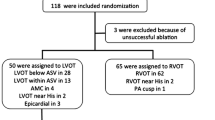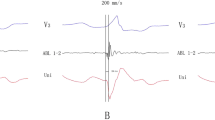Abstract
Background: Critical sites within reentry circuits of postinfarction ventricular tachycardia (VT) were identified during sinus rhythm (SR) and VT to determine whether electrogram characteristics during SR may be helpful in identifying successful ablation sites.
Methods: In 33 patients (mean age 67 ± 11 yrs) with prior infarction, mapping and radiofrequency (RF) catheter ablation of 57 hemodynamically-tolerated VT's (cycle length 478 ± 96) were performed. The morphologies of electrograms (EGM) at sites of concealed entrainment (CE) were compared during SR and VT. RF energy was delivered at 94 sites (51 successful and 43 unsuccessful ablation sites).
Results: During SR, isolated potentials (IP), but not late potentials (LP) recorded via the mapping catheter, were associated with successful ablation. At 29/39 sites with an IP during sinus rhythm, an isolated diastolic potential (IDP) also was present during VT, whereas at 4 sites IP's were present only during SR (p < 0.001). At 11/29 sites where isolated potentials were present during SR and VT, the morphology of the isolated potential during VT and SR was similar; and all but one of these sites were successful ablation sites (p = 0.01). The EGM amplitude during VT correlated with the amplitude during SR (R = 0.9, p < 0.001). An identical pacemap was present during SR at 33/94 sites; this was not associated with successful ablation.
Conclusion: SR mapping may be helpful in identifying critical sites of reentry in postinfarction VT. At sites within the reentry circuit, characteristics of sinus rhythm EGM's that are associated with successful ablation include the presence of IP's, but not the presence of LP's.
Similar content being viewed by others
References
Kienzle MG, Miller J, Falcone RA, Harken A, Josephson ME. Intraoperative endocardialmapping during sinus rhythm: Relationship to site of origin of ventricular tachycardia. Circulation 1984;70:957–965.
Cassidy DM, Vassallo JA, Buxton AE, Doherty JU, Marchlinski FE, Josephson ME. The value of cathetermapping during sinus rhythm to localize site of origin of ventricular tachycardia. Circulation 1984;69:1103–1110.
Harada T, Stevenson WG, Kocovic DZ, Friedman PL. Catheter ablation of ventricular tachycardia after myocardialinfarction: Relation of endocardial sinus rhythm late potentials to the reentry circuit. J Am Coll Cardiol. 1997;30:1015–1023.
Bogun F, Knight B, Goyal R, Strickberger SA, Hohnloser SH, Morady F. Clinicalvalue of the postpacing interval for mapping of ventricular tachycardia in patients with prior myocardial infarction. J Cardiovasc Electrophysiol 1999;10:43–51.
Hummel D, Strickberger S, Daoud E, Niebauer M, Bakr O, Man K, et al.Results and efficency of programmed ventricular stimulation with four extrastimuli compared with one, two, and three extrastimuli. Circulation 1994;90:2827–2823.
Josephson M. Clinical Cardiac ElectrophysiologyTechniques and Interpretations, 2nd ed. Lea & Febiger, 1993, p. 427.
Morady F, Kadish A, Rosenheck S, Calkins H, Kou W, De Buitleir M, et al. Concealed entrainment as a guide for catheter ablation of ventricular tachycardia in patients with prior myocardial infarction.J Am Coll Cardiol 1991;17:678–689.
Stevenson W, Khan H, Sager P, Saxon L, Middleknauf H, Natterson P, et al. Identification of reentry circuit sites during mapping and radiofrequency ablation of ventricular tachycardia late after myocardial infarction. Circulation 1993;88:1647–1670.
Schilling RJ, Peters NS, Davies DW. Feasibility of a noncontact catheter for endocardial mapping of human ventriculartachycardia. Circulation 1999;99:2543–2552.
Strickberger SA, Knight BP, Michaud GF, Pelosi F, Morady F. Mapping and ablation of ventricular tachycardia guided by virtual electrograms using a noncontact, computerized mapping system. J Am Coll Cardiol 2000;35:414–421.
Bogun F, Bahu M, Knight BP, Weiss R, Goyal R, Daoud E, et al. Response to pacing at sites of isolated diastolic potentials during ventricular tachycardia in patients with previous myocardial infarction. J Am Coll Cardiol 1997;30:505–513.
Marchlinski FE, Callans DJ, Gottlieb CD, Zado E. Linear ablation lesions for control of unmappable ventricular tachycardia in patients with ischemic and nonischemic cardiomyopathy. Circulation 2000;101:1288–1296.
Stevenson W, Sager P, Friedman P.Entrainment techniques for mapping atrial and ventricular tachycardias. J Cardiovasc Electrophysiol 1995;6:201–216.
Morady F, Kadish AH, DiCarlo L, Kou WH, Winston S, deBuitlier M, et al. Long-term results of catheterablation of idiopathic right ventricular tachycardia [see comments]. Circulation 1990;82:2093–2099.
Soejima K, Stevenson WG, Delacretaz E, Suzuki M, Friedman PL. Cooled versus standart radiofrequency ablation fortermination of ventricular tachycardia. PACE 2000;23:674, A-488.
Author information
Authors and Affiliations
Rights and permissions
About this article
Cite this article
Bogun, F., Bender, B., Li, YG. et al. Analysis During Sinus Rhythm of Critical Sites in Reentry Circuits of Postinfarction Ventricular Tachycardia. J Interv Card Electrophysiol 7, 95–103 (2002). https://doi.org/10.1023/A:1020832502838
Issue Date:
DOI: https://doi.org/10.1023/A:1020832502838




